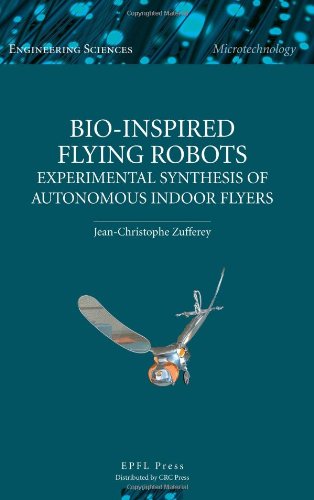Bio-inspired Flying Robots: Experimental Synthesis of Autonomous Indoor Flyers (Engineering Sciencs: Microtechnology) - Hardcover

Inhaltsangabe
This book demonstrates how bio-inspiration can lead to fully autonomous flying robots without relying on external aids. Most existing aerial robots fly in open skies, far from obstacles, and rely on external beacons, mainly GPS, to localise and navigate. However, these robots are not able to fly at low altitude or in confined environments, and yet this poses absolutely no difficulty to insects. Indeed, flying insects display efficient flight control capabilities in complex environments despite their limited weight and relatively tiny brain size.
From sensor suite to control strategies, the literature on flying insects is reviewed from an engineering perspective in order to extract useful principles that are then applied to the synthesis of artificial indoor flyers. Artificial evolution is also utilised to search for alternative control systems and behaviors that match the constraints of small flying robots. Specifically, the basic sensory modalities of insects, vision, gyroscopes and airflow sense, are applied to develop navigation controllers for indoor flying robots. These robots are capable of mapping sensor information onto actuator commands in real time to maintain altitude, stabilize the course and avoid obstacles. The most prominent result of this novel approach is a 10-gram microflyer capable of fully autonomous operation in an office-sized room using fly-inspired vision, inertial and airspeed sensors.
This book is intended for all those interested in autonomous robotics, in academia and industry.
Die Inhaltsangabe kann sich auf eine andere Ausgabe dieses Titels beziehen.
Reseña del editor
This book demonstrates how bio-inspiration can lead to fully autonomous flying robots without relying on external aids. Most existing aerial robots fly in open skies, far from obstacles, and rely on external beacons, mainly GPS, to localise and navigate. However, these robots are not able to fly at low altitude or in confined environments, and yet this poses absolutely no difficulty to insects. Indeed, flying insects display efficient flight control capabilities in complex environments despite their limited weight and relatively tiny brain size.
From sensor suite to control strategies, the literature on flying insects is reviewed from an engineering perspective in order to extract useful principles that are then applied to the synthesis of artificial indoor flyers. Artificial evolution is also utilised to search for alternative control systems and behaviors that match the constraints of small flying robots. Specifically, the basic sensory modalities of insects, vision, gyroscopes and airflow sense, are applied to develop navigation controllers for indoor flying robots. These robots are capable of mapping sensor information onto actuator commands in real time to maintain altitude, stabilize the course and avoid obstacles. The most prominent result of this novel approach is a 10-gram microflyer capable of fully autonomous operation in an office-sized room using fly-inspired vision, inertial and airspeed sensors.
This book is intended for all those interested in autonomous robotics, in academia and industry.
„Über diesen Titel“ kann sich auf eine andere Ausgabe dieses Titels beziehen.
Weitere beliebte Ausgaben desselben Titels
Suchergebnisse für Bio-inspired Flying Robots: Experimental Synthesis...
Bio-inspired Flying Robots: Experimental Synthesis of Autonomous Indoor Flyers Format: Hardcover
Anbieter: INDOO, Avenel, NJ, USA
Zustand: New. Brand New. Bestandsnummer des Verkäufers 9781420066845
Neu kaufen
Anzahl: Mehr als 20 verfügbar
Bio-inspired Flying Robots: Experimental Synthesis of Autonomous Indoor Flyers (Engineering Sciencs: Microtechnology)
Anbieter: Mispah books, Redhill, SURRE, Vereinigtes Königreich
Hardcover. Zustand: Like New. Like New. book. Bestandsnummer des Verkäufers ERICA75814200668466
Gebraucht kaufen
Anzahl: 1 verfügbar
Bio-inspired Flying Robots: Experimental Synthesis of Autonomous Indoor Flyers
Anbieter: THE SAINT BOOKSTORE, Southport, Vereinigtes Königreich
Hardback. Zustand: New. New copy - Usually dispatched within 7-11 working days. Bestandsnummer des Verkäufers B9781420066845
Neu kaufen
Anzahl: 15 verfügbar

